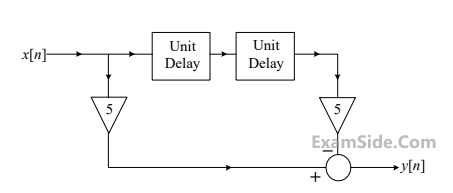Transmission of Signal Through Discrete Time Lti Systems · Signals and Systems · GATE ECE
Marks 1
1
A causal and stable LTI system with impulse response h(t) produces an output y(t) for an input signal x(t). A signal x(0.5t) is applied to another causal and stable LTI system with impulse response h(0.5t). The resulting output is ____.
GATE ECE 2024
2
Consider a four-point moving average filter defined by the equation $$y[n] = \sum\limits_{i = 0}^3 {{\alpha _i}x[n - i]} $$. The condition on the filter coefficients that results in a null at zero frequency is
GATE ECE 2015 Set 3
Marks 2
1
The direct form structure of an FIR (finite impulse response) filter is shown in the figure.


The filter can be used to approximate a
GATE ECE 2016 Set 3
2
A system with transfer function H(z) has impulse response h(.) defined as h(2) = 1, h(3) = - 1 and h (k) = 0 otherwise. Consider the following statements.
S1: H(z) is a low-pass filter.
S2: H(z) is an FIR filter.
S1: H(z) is a low-pass filter.
S2: H(z) is an FIR filter.
Which of the following is correct?
GATE ECE 2009
3
A signal x(n)$$ = \sin ({\omega _0}\,n + \phi )$$ is the input to a linear time-invariant system having a frequency response $$H({e^{j\omega }})$$.If the output of the system is $$Ax(n - {n_0})$$, then the most general form of $$\angle H({e^{j\omega }})$$ will be
GATE ECE 2005